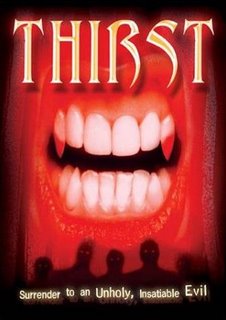 Directed By: Rod Hardy
Directed By: Rod Hardy
Release Date: 1979
Contains spoilers
It was purely coincidental that I had decided to review this Australian film at the same time that I discovered there was to be not one but two new vampire films, both called “The Thirst”, released. The DVD had been hovering around on my ‘really should get it out and review it’ list for some time.
 The film begins with a woman, we later discover to be Kate Davis (Chantal Contouri), waking in a coffin and screaming; there are tears on her cheeks. She makes her way through the walled up crypt to a stream of light. We hear voices discussing her, she is responding says one, is it safe asks another. We hear that it is a standard conditioning procedure. It is not your standard opening to a vampire movie, sure we have the waking in a coffin but most newly risen vampires don’t scream and what is this about conditioning? Then again, Thirst is anything but standard.
The film begins with a woman, we later discover to be Kate Davis (Chantal Contouri), waking in a coffin and screaming; there are tears on her cheeks. She makes her way through the walled up crypt to a stream of light. We hear voices discussing her, she is responding says one, is it safe asks another. We hear that it is a standard conditioning procedure. It is not your standard opening to a vampire movie, sure we have the waking in a coffin but most newly risen vampires don’t scream and what is this about conditioning? Then again, Thirst is anything but standard.
The film cuts back a week and Kate is at home with her housekeeper Lori (Rosie Stugess) and she is getting ready for a holiday. Her boyfriend, Derek (Rod Mullinar) – a man with a bad porn film moustache, visits her but they are unaware that they are observed. She is then discussed in some form of board room. One of the people, Mr Hodge (Max Phipps), is excited about his and her family being reunited. Dr Fraser (David Hemmings) warns that it will only be by her consent.
The next day Kate picks up some milk and then speaks on the phone to Derek. As she does so the cat, back in the kitchen, knocks over the milk carton. The carton contains blood. She tries to make a phone call and the line emits a high pitched tone and figures burst in. Kate comes round just after she is transferred from a plane to a car. She is taken to a facility run by the Hyma society. They talk to her about her ancestry and one of the society, Mrs Barton (Shirley Cameron), tells her that she is a descendant of Countess Báthory. The picture she is shown has Báthory with fangs. Now this is out with the historical Báthory, of course, but fits in well with the film as we shall see.
The Hyma society dislike the word vampire, they see themselves as a superior race that have discovered that the drinking of blood provides youth and power.  The facility itself is a farm; inmates (called alternatively donors or blood cows) are kept on the farm, prisoners who are given tranquilisers to keep them docile. There is a festival of some of the 70,000 vampires worldwide to take place there and, when the visitors are given a tour of the facility, we discover that the farms were created as an answer to blood impurities. Certain blood diseases are mentioned, and they also mention that penicillin could lead the vampire to suffer from anaphylactic shock. This is not expanded upon, and one wonders whether the intolerance to penicillin is part of their vampiric condition or not? The blood is packaged in milk cartons for delivery to society members.
The facility itself is a farm; inmates (called alternatively donors or blood cows) are kept on the farm, prisoners who are given tranquilisers to keep them docile. There is a festival of some of the 70,000 vampires worldwide to take place there and, when the visitors are given a tour of the facility, we discover that the farms were created as an answer to blood impurities. Certain blood diseases are mentioned, and they also mention that penicillin could lead the vampire to suffer from anaphylactic shock. This is not expanded upon, and one wonders whether the intolerance to penicillin is part of their vampiric condition or not? The blood is packaged in milk cartons for delivery to society members.
 We also discover that the highest honour for a donor, though I doubt many of them would see it, is to be completely exsanguinated. Though it is not mentioned, one assumes that the society believes the second highest honour to be that of taking part in a ritual.
We also discover that the highest honour for a donor, though I doubt many of them would see it, is to be completely exsanguinated. Though it is not mentioned, one assumes that the society believes the second highest honour to be that of taking part in a ritual.
We do get to see the society celebrate its rituals. This was interesting as they seem to mix the very modernistic view of vampires that the film creates, which tie in heavily with Báthory the serial killer, with more traditional vampire myth imagery. The vampire puts in silvered false fangs; hence the picture shown of Báthory might have been wearing such fangs rather than sprouting them (super)naturally. Then we see the eyes flash red as they approach the victim. It was this eyes flashing red that was anachronistic and more traditional in nature. It might have been part of Kate’s conditioning to see this but we also see her eyes flash red at one point. Perhaps there is something more supernatural going on? This is underlined when the cat knocks over the carton of blood at the beginning of the film, Kate gets blood on her finger and, almost subconsciously, licks the blood from her finger – the cat hisses at her and this leaves a feeling that there is a supernatural element also. It should also be noted, as per the ritual screenshot above, that the belief that vampirism offered youth seems to have been optimistic to say the least.
It was this eyes flashing red that was anachronistic and more traditional in nature. It might have been part of Kate’s conditioning to see this but we also see her eyes flash red at one point. Perhaps there is something more supernatural going on? This is underlined when the cat knocks over the carton of blood at the beginning of the film, Kate gets blood on her finger and, almost subconsciously, licks the blood from her finger – the cat hisses at her and this leaves a feeling that there is a supernatural element also. It should also be noted, as per the ritual screenshot above, that the belief that vampirism offered youth seems to have been optimistic to say the least.
 The majority of the film surrounds Kate’s conditioning, with almost a bad cop, Mrs Barton, and a good cop, Dr Fraser, scenario going on. The conditioning itself is psychotropic in nature, with Kate forced into almost familiar surroundings that become twisted and nightmarish. This is both the strength and weakness of the film. Strength because, other than one really bad effect that I’ll mention later, it is really well done, weakness because that is about the top and bottom of the story, there seems to be little other meat to it. The concept of the Hyma society was brilliant and I would have liked to have seen more about them and their ways.
The majority of the film surrounds Kate’s conditioning, with almost a bad cop, Mrs Barton, and a good cop, Dr Fraser, scenario going on. The conditioning itself is psychotropic in nature, with Kate forced into almost familiar surroundings that become twisted and nightmarish. This is both the strength and weakness of the film. Strength because, other than one really bad effect that I’ll mention later, it is really well done, weakness because that is about the top and bottom of the story, there seems to be little other meat to it. The concept of the Hyma society was brilliant and I would have liked to have seen more about them and their ways.
The acting is passable, though I was not convinced by Contouri’s performance as Kate, okay she was on the verge of insanity but it did seem a little too whiney. This woman was, allegedly, a successful business woman. I would have expected a little more get up and go (literally). There was one scene where she slapped Mrs Barton but, generally, she was only ever portrayed as the victim.
 The poor effect I mentioned earlier is pictured - the rotting face of Kate’s housekeeper. An unfortunate effect as it looked so very false. The rest of the effects were well done, though admittedly most centred around blood. The soundtrack was, unfortunately, very cheesy.
The poor effect I mentioned earlier is pictured - the rotting face of Kate’s housekeeper. An unfortunate effect as it looked so very false. The rest of the effects were well done, though admittedly most centred around blood. The soundtrack was, unfortunately, very cheesy.
This is a film that will annoy the traditional vampire fan but I was taken by its unusual approach to the subject matter. Certainly the concept of actually farming humans has been used since but this did it in such a classy way, which almost felt as though the spirit of The Prisoner had been captured when it came to the drugged and docile donors.  Despite some of the gripes I have mentioned this is certainly one that I would recommend genre fans looking at and also anyone interested in seeing a film that chronicles a psychological dismemberment of the victim – I realise I have mentioned little about the conditioning but as it is the main thrust of the film I wanted to leave it fairly sacrosanct.
Despite some of the gripes I have mentioned this is certainly one that I would recommend genre fans looking at and also anyone interested in seeing a film that chronicles a psychological dismemberment of the victim – I realise I have mentioned little about the conditioning but as it is the main thrust of the film I wanted to leave it fairly sacrosanct.
A strong 6.5 out of 10 for the originality shown.
The imdb page is here.
Monday, September 25, 2006
Thirst {1979} – review
Posted by
Taliesin_ttlg
at
7:08 AM
![]()
Labels: Erzsébet Báthory, pureblood, vampire
Subscribe to:
Post Comments (Atom)
















No comments:
Post a Comment